Olympus Zuiko ED 18-180mm f/3.5-6.3
Zoom lenses with a ratio of 10:1 or greater have become known as Superzooms and to some are the Holy Grail of interchangeable lenses. The reality is that they need a number of compromises to achieve their range and make a ‘Jack of all Trades’ rather than master of any. We take a look at this 4/3rds mount offering from Olympus.
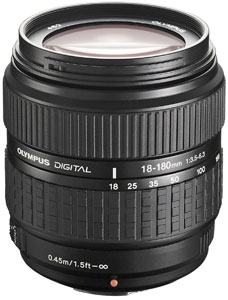 Specifications
Specifications
- Focal length 18-180mm (36-360mm equivalent)
- Construction 15/13 elements/groups
- Max aperture f/3.5-6.3
- Angle of view 62-6.9°
- Closest focus 0.45m
- Filter size 62mm
- Weight 0.435kg
- Dimensions 78x84.5mm
- Lens hood LH-65 (supplied)
- Price (SRP) £389.00
- Mount 4/3rds
Build and handling
Built exclusively for the 2x crop Four-thirds mount, this lens is quite compact for its range, increasing its length through a double trombone by around 52mm when zoomed to its full stretch. The well torqued zoom ring, marked at 18, 25, 35, 50, 100 and 180mm is plenty wide enough for mast hands while the narrower manual focus ring is a tad slacker and is redundant unless the fly-by-wire manual focus is switched on through the camera. The near bucket shaped hood fits with a firm bayonet to the front element that sports a deep 62mm filter thread.
The autofocus is reasonably quiet with just a whisper of whine as it searches through the blur looking for the sharp bit. At the short end, this is found and locked onto well, although at the longer focal lengths some hunting or checking either side of the lock is tried before final lock is achieved. This is more noticeable in lower light conditions. Overall the AF is quite accurate and as the focus is achieved internally the lens does not extend during the process. This also keeps the front element from rotating, handy if you are using filters.
Optical quality
Billed as an f/3.5-6.3 aperture lens, the f/3.5 quickly drops off and has gone past the f/4 point before it reaches 25mm in focal length. At 77mm it passes the f/5.6 stop and, because the whole lens is electronically operated and does not go further than f/22, it leaves over half the focal range with only five useful stops compared to the normal six or seven of a conventional lens.
When set to the widest focal length, the lens is an average performer where resolution is concerned and for most of the frame, chromatic aberrations are fairly well controlled although still evident at the edges. As the lens is extended however, things do not improve and there is noticeable CA towards the edges along with a decrease in resolution. The decrease is not severe and Olympus has done well to keep the performance fairly consistent throughout the 10:1 focal range. It would have been nice though, if the start point had been better. Flare and ghosting on the other hand, do seem to be well controlled throughout the coverage of the optic and are difficult to induce, even with a strong torch.
 In this shot of a signboard the barrel distortion at the 18mm end is very evident. 1/200sec at f/5 and ISO100 on an E-500. | 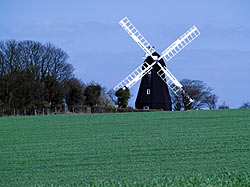 At 180mm the distortion is nowhere near as evident but the lens is becoming a little soft. |
 The focal range of the lens, at a ratio of 10:1 is useful as a walkabout lens. 1/100sec at f/8 and set at 33mm. |  At less than half a metre throughout the range, the close focus ability is useful. 1/100sec at f/8 and set at 180mm. |
Click on each comparision photo below to view full size versions
Below is our lens test data. To find out how to use these graphs look at this article: How we test lenses
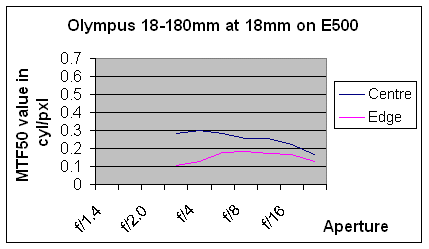
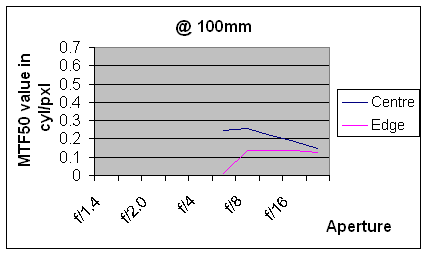
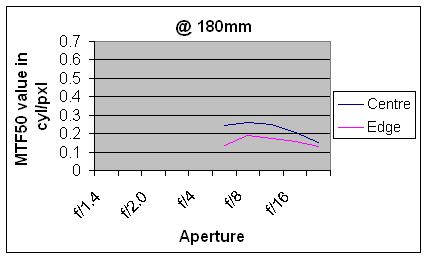
Verdict
Olympus are putting a lot of effort into the 4/3rds system and the build and feel of this lens is on the good side, not appearing too light or plasticy. Having said that, I do wonder if the wholly electronic nature of these lenses is prone to letting go if the lens gets a knock of some sort but it is not something I have worked out a non-destructive test for! The wide focal range of these superzooms are admirable for their versatility but are not yet capable of replacing separate lenses for quality results.
In summary, the positive points of the Olympus Zuiko 18-180mm f/3.5-6.3 lens are:
![]() Good focal range (although not as wide on a 2x crop)
Good focal range (although not as wide on a 2x crop)
![]() Compact size and weight
Compact size and weight
![]() Appears well built
Appears well built
The negative points are:
![]() Results not stunning
Results not stunning
![]() CA towards the edges
CA towards the edges
![]() MF electronically controlled
MF electronically controlled
![]() Not the cheapest available
Not the cheapest available
Check out the latest price of the Olympus Zuiko ED 18-180mm f/3.5-6.3 here
Test by Ian Andrews www.wildaboutkent.com
Add your message
Please login here or if you've not registered, you can register here. Registering is safe, quick and free.
photodo Stats
428 MTF tests
74 in-depth photodo reviews
100+ users join each day
Help the lens community by reviewing or rating a lens today via our lens search
Latest Lens Reviews
- Chinon 28mm f/2.8 Vintage Lens Review
- Canon EF 70-200mm f/4L IS II USM Lens Review
- Samyang AF 85mm f/1.4 EF Review
- Sigma 70mm f/2.8 DG Macro Art Review
- Samyang AF 24mm f/2.8 FE Review
- Meike 50mm f/1.7 Review
- Tamron 70-210mm f/4 Di VC USD Review
- Lensbaby Burnside 35mm f/2.8 Review
- Asahi Super Takumar 50mm f/1.4 Review
- Asahi Super-Multi-Coated Takumar 135mm f/3.5 Review




